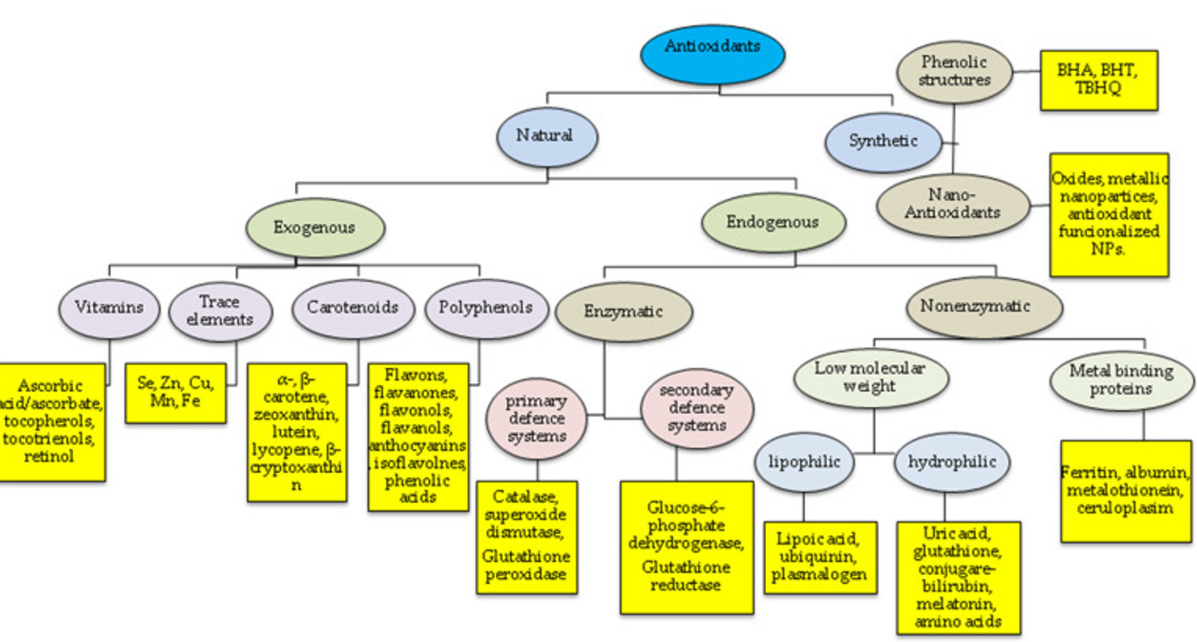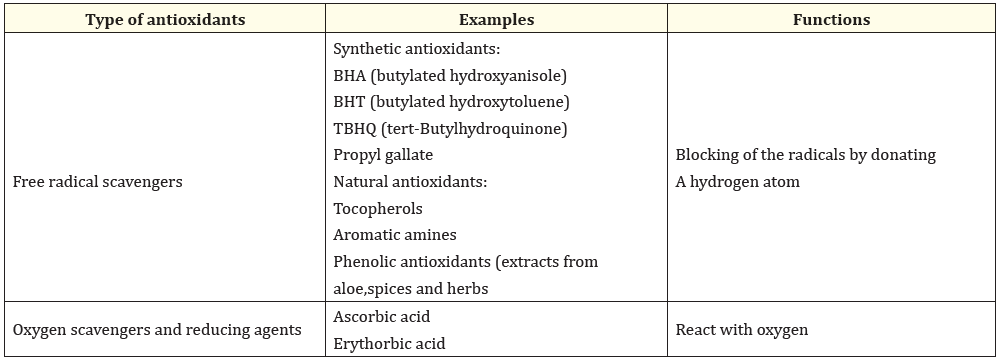Jilu Jessy Abraham1*, Anil Melath2, Subair K1, Afna fathima3 and Adla Nadeer3
1Reader, Department of Periodontics, Mahe institute of Dental Sciences, Chalakkara, Mahe
2Principal and HOD Department of Periodontics, Mahe institute of Dental Sciences, Chalakkara, Mahe
3Final Year Student, Mahe institute of Dental Sciences, Chalakkara, Mahe
*Corresponding Author:Jilu Jessy Abraham, Reader, Department of Periodontics, Mahe institute of Dental Sciences, Chalakkara, Mahe.
Received: October 03, 2024; Published: October 26, 2024
Citation: Jilu Jessy Abraham., et al. “Antioxidants and Optimal Health". Acta Scientific Dental Sciences 8.11 (2024):54-60.
The presence of free radicals in biological materials was first time discovered about 70 years ago. Since then numerous studies have been done and the benefits of free radicals was introduced. Today we know that antioxidant are by products of the enzymatic reactions taking place in an organism. Antigen are biological macromolecules with immune regulation. Anti-aging, anti-radiation, anti-fatigue, anti-inflammation effects [6].
Overproduction of free radicals causes, oxidative stress, aging processes and various diseases like cancer, rheumatoid arthritis, neurodegenerative disease like Alzheimer and Parkinson, atherosclerosis, pulmonary diseases and DNA damage [12].
Hence, compounds with antioxidants are very important these days because they keep in balance between the production of free radical and the speed of their neutralization the body.
Keywords: Oxygen; Antioxidants; Physiological
Antioxidants are substances that prevents oxidation of other compounds. Antioxidants has become a necessity in food products to prevent food degradation. Widely used synthetic anti-oxidants are BHA, BHT, TBHQ. Now there is a increased demand for natural compounds showing anti -oxidant activity. This include plants, eg:-fruits, vegetables, spices etc. Aloe vera contains anti-oxidant which is used in the cosmetic, pharmaceutical, food industry. It has increased shelf life and nutritional value of food [4].
Antioxidants have many medicinal purposes. eg: flavonoids which helps to reduce the risk of mortality from coronary heart diseases and myocardial infarction. Also long term consumption of plant polyphenols can protect as from a range of diseases such as cancers, cardiovascular diseases, osteoporosis and diabetes [6].
General health and degenerative diseases of aging can be improved by consuming recommended amount of fruits and vegetables containing anti-oxidants. The powerful action of anti-oxidants in preventing premature lipid oxidation in food suggests that the same compound when consumed with the daily diet, could unfold anti -oxidative and anti- aging effects in human body. Therefore it has been hypothesized that anti-oxidants are helpful in preventing various diseases [9].
Antioxidants are also widely being used in general clinical practices. This is due to the increased role of free radicle oxidative damage of human diseases which shows potential in dental practices [10].
In the late 19th and early 20th century, extensive study was devoted to the uses of antioxidants in important industrial processes such as the prevention of metal corrosion the vulcanization of rubber, and the polymerization of fuels in the fouling of combustion engines.
The use of antioxidants was an ancient practice for food preservation, meats and fish were permeated with phenolic compounds. Subsequently some researcher’s observed that addition of small amounts certain compounds could delay deterioration of other substances in the air.

Figure a

Table a
In recent physiological studies it shows that it is more advisable to maintain the delicate redox balance than to interfere with the antioxidant homeostasis by a non-physiological, excessive exogenous supply of antioxidants in healthy humans [4].
Synthetic antioxidants may cause adverse effects in humans, hence natural sources of antioxidants were sought after. Various studies have shown the effectiveness of certain plant materials in the reduction of oxidation reaction. Such plants have been used by the humans for a long period of time due to their positive effects, they include tea, coffee, aloe, herbs and spices. These materials have high active compound content which makes them a suitable source of effective and safe natural food additives [4].
Based on mechanism of action antioxidants are classified into primary and secondary antioxidants. primary antioxidants include natural and synthetic materials. In which primary natural antioxidants include tocopherols, flavonoids and esters of gallic acid. The secondary antioxidants include peroxide decomposers such as thioethers, methionine, metal chelaters and glutathione peroxidase [4].
Proteins also inhibit lipid oxidation in food i.e., proteins originating from milk, blood plasma and soy protein. Procine in blood plasma contains antioxidant proteins such as albumin and transferrin. Peptides also inhibits lipid oxidation in foods eg :- cansein, soy and egg yolk has shown to inhibit antioxidants in various muscle foods . Carnosine and anserine are histidine containing dipeptides found in skeletal muscle and they exhibit antioxidants properties [4].
Antioxidants are substances that when present even at low concentration will significantly delay or inhibit oxidation of the oxidative substrate. Free radicals that are harmful to the body are produced during metabolism and sometimes the immune system cells create them to neutralize harmful pathogens. Antioxidants neutralize free radicals by donating one of their electrons, ending the electron stealing reaction. Environmental factors like pollution, radiation and smoking also produce free radicals. The antioxidants does not become a free radicals by donating electrons because they are stable in both forms [13]. There are three types of important antioxidants they are the chain breaking or scavenging ones (eg: vitamin E, C and A), those containing thiol groups (the preventive antioxidants: albumin, transfer in, lactoferrin) and the enzyme antioxidants (eg: catalase and glutathione peroxidase). The delicate balance between beneficial and harmful effects of free radicals is a very important aspect of living organisms and it is achieved “redox regulation”. The process of redox regulation protects living organisms from various oxidative stresses and maintain “redox homeostasis” [12].
Reactive oxygen species (ROS) are produced by various endogenous (cytokines, growth factors and metabolic processes) and exogenous substances (cigarette smoke). ROS has an unpaired electron which makes the highly reactive and dangerous to cell life thus antioxidants provide an extra electron needed to stabilize or breakdown ROS [7].
An efficient antioxidant should be able to detect and prevent a chain of oxidative propagation. It does so by stabilizing the free radical generation by oxidation, thereby reducing the oxidative damage to the body. There are two main types of anti-oxidants Primary and secondary or Preventive. Secondary anti-oxidant methods may include iron blockade, inhibition of lipid hydroperoxides by disrupting the production of unwanted volatiles reactivation of key anti-oxidants and termination of single oxygen. Therefore anti -oxidants can be defined as those substances, small amounts that works to prevent or significantly delay oxidation of oxidizable substances such as fats [9].
Oxygen free radicals or ROS are well recognized for playing a dual role as both harmful and beneficial to the living system. Beneficial effects of ROS occur at low or moderate concentration. For example, they act as a defense against infectious agents, in a number of cellular signaling system, it also has a role in cellular response to noxia. The harmful effects of ROS is due to over production of ROS on one side and deficiency of enzymatic and non-enzymatic antioxidants on the other side. The harmful effects of ROS causes biological damage. It is termed as oxidative stress. The excessive production of ROS causes damage to cellular lipids, proteins and DNA inhibiting their normal function. Therefore, balance of oxidative stress is a very important aspect of living organism and is achieved by mechanism called “reduction regulation” [12].
A great number of physiological functions or maintained by the redox signalling pathway such as
Oxidative stress have been the cause of various diseases such as cardiovascular disease, cancer, neurological disorder, diabetes, ischemia or reperfusion, other diseases and aging [12].
Antioxidants are involved in protection of the biological system by
Intake of antioxidants helps to prevent free radical formation, which in turn prevents acute or chronic diseases, such as Alzheimers, cancer, aging, liver, cardiovascular diseases [6].
Synthetic or natural antioxidants at optimum concentration act as a tool for early prevention of this condition. Antioxidants, avert or remove oxidative stress related diseases by counter acting the deteriorating effect of ROS. Antioxidants also nullify the action of free radicals and provide the finest cellular function. Antioxidants such as vitamin C is a water-soluble antioxidant which act as protection for lipids from peroxidation. Synthetic antioxidants are used to preserve Bloom, nutritional importance, flavor and color of food products. The harmful effects of ROS are controlled by the antioxidant action of the non-enzymatic antioxidant in addition to antioxidant enzymes such antioxidant defenses are very important for direct removal of free radicals and protection of biological site. The present lifestyle of majority of people leads to large amount of free radical in human body which damages cells, tissues and organs which shortens the life span. Intake of antioxidant helps to reduce excess formation of free radical which in turn reduces acute and chronic diseases [6].
Antioxidants are now commonly used in general clinical practice. Growing interest in the role of free radicals and oxidative damage in human disease, coupled with increased research, suggests their potential application in dentistry as well. In developed countries, the consumption of antioxidant supplements has become widespread, with approximately one-third of adults regularly using them [9].
Free radicals seem to influence many oral diseases, most commonly periodontitis. Though oxidative stress is implicated in the pathogenesis of periodontitis, it is seen that the total antioxidant capacity of gingival crevicular fluid (GCF) volume and2plasma appears compromised. The periodontal tissues also provide an ideal medium to study the mechanisms of reactive oxygen species (ROS) mediated 3 tissue damage and of antioxidant defense in response to bacterial colonisation. Ascorbic acid deficiency has been shown to be a conditioning factor in the development of gingivitis [6].
Antioxidant therapy may be a double edged sword with negative and undesirable effects, if the safety threshold of the therapeutic dose is surpassed. If administration of antioxidant supplements decreases free radicals, it may interfere with essential defensive mechanisms for eradicating the organism of damaged cells, including those that are precancerous and cancerous. Hence there is a need for a specific endpoint while evaluating the efficacy of antioxidants. Clinical studies to identify biomarkers for antioxidant status and oxidative stress, cytokine multiplexing and gene arrays need to be done. The ratio of overall benefit: risk assessment needs to be evaluated when prescribing these in clinical dentistry. The following points should be considered strongly by the dental practitioners before considering antioxidant therapy:
(The disease should ideally have been associated with increased lipid peroxidation or oxidation of protein or DNA).
Yes, that's correct. Antioxidants are beneficial in individuals who have high baseline levels of reactive oxygen species (ROS), which can cause oxidative stress. By neutralizing ROS, antioxidants can help reduce oxidative damage and its associated complications. However, in individuals with lower innate levels of ROS, excessive antioxidant supplementation can potentially disrupt normal cellular signaling and redox balance, leading to harmful effects. Therefore, the use of antioxidants should be tailored to the specific needs and conditions of the individual [6].
Currently, there are few studies available to extrapolate the therapeutic effects of antioxidants in dental practice. While there have been promising results overall, the benefit-to-risk ratio should be carefully considered [6].
Ongoing research illustrates positive findings for antioxidants in clinical dentistry. However, numerous issues need to be addressed due to lack of firm evidence. A substantial gap still exists in our knowledge of bioavailability, biotransformation and mechanism of action of antioxidants. Large scale RCTs and unbiased studies addressing the safety and standardization issue of antioxidants in dentistry are also required [6].
The endogenous defence mechanism of our body is damaged by the imbalance between antioxidant defence mechanism and the oxidative stress. Oxidative stress show crucial role in the propagation of many life threatening disease. Researchers are seeking natural sources of antioxidant which substitute the synthetic drugs .The protective effect of antioxidant continues to be studied around the world [4].
Copyright: © 2024 Jilu Jessy Abraham.,et al. This is an open-access article distributed under the terms of the Creative Commons Attribution License, which permits unrestricted use, distribution, and reproduction in any medium, provided the original author and source are credited.
ff
© 2024 Acta Scientific, All rights reserved.